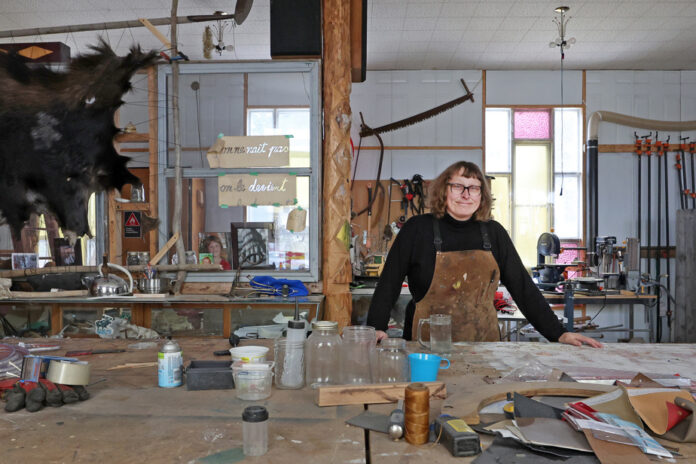(Sept-Îles (Moisie)) Rebellious child of Sept-Îles, the artist Johanne Roussy settled in Moisie to concretize the work of her life: a self-managed and self-financed artist center that offers creative residencies.
There was still snow on the North Shore when La Presse visited the Atelier de la 8e île. May had not yet shown the tip of her nose and the cold did not suggest that a few weeks later, the community installed on an old radar base dating from the Cold War would be temporarily evacuated under the threat of forest fires.
Since 2012, artist Johanne Roussy has occupied the building that once housed the garrison’s bi-denominational church. Once through the front door, worshipers had the option of going left, where Catholic masses were held, or right, where Protestant celebrations were held. Nowadays, these places shelter respectively a space of diffusion cluttered with all a bric-a-brac and a workshop, also cluttered with all a whole bric-a-brac.
The Atelier de la 8e île is a work in progress that the artist, who defines herself as a social sculptor, carries at arm’s length: she receives no funding to support this place where artists from the region and others came from Montreal to create away from the noise of the city.
Johanne Roussy grew up in Sept-Îles, practically on the dividing line between the Uashat reserve and the town of the Whites. As a child, she had this feeling of being the other, in the eyes of her Innu neighbors. Her feeling turned into curiosity and a desire to build bridges. For her, this involves the need to question and criticize our colonial past.
“I called this place the Atelier de la 8e île to make it romantic,” she says. It’s my imaginary island next to Sept-Îles. The imaginary and the political are linked, on the other hand. The artist experiences dissatisfaction and mine is called Sept-Îles. I am a bit of a rebellious child of mining and colonization. »
His art is committed, marked by a desire to rethink our relationships with our indigenous neighbors and a concern for the protection of the environment. “Here, we have to live the territory,” says Johanne Roussy, speaking of the North Shore and in particular Moisie. She defines herself as a social sculptor and wants to reach beyond the intimate, through various mediums (sculpture, installations, cinema, performance, etc.).
She also speaks of “relational” art, because the desire to make people think and to provoke a dialogue is particularly dear to her. These were, among other things, the objectives of a series of actions carried out with the Sept-Îles collective without uranium, including a snowmobile broom which, filmed from the air, represented the symbol of radioactivity. This kind of shock gesture that can attract the attention of the media.
Even more concretely, Johanne Roussy offers creative residencies to other artists from diverse backgrounds. “I dreamed of making people love the Côte-Nord so that these artists could defend us,” she said. I am convinced that artists can change things, in their own way. »
The list of creators who have passed through the Atelier de la 8e île includes, among others, filmmaker and author Anaïs Barbeau-Lavalette, actress and playwright Pol Pelletier, musician Zal Sissokho and poetess Noémie Pomerleau-Cloutier, whom La Presse has encountered on the spot.
“It’s a territory that really speaks to me a lot and where I feel good, explains the latter, who is from Baie-Comeau and who needs nature and water to write. It is also a place where I can test things. This time, I read the first drafts of poems in front of an audience. I would not have done that in Montreal or at L’Ouvre-Boîte culturel de Baie-Comeau. »
Johanne Roussy is a “real punk”, according to Noémie Pomerleau-Cloutier. A real outsider. The creator of Atelier de la 8e île confirms that she is well outside of established structures, which gives her the freedom she needs. “I want to remain the girl who welcomes people into her shop,” she says, “which works by invitation and chance encounters. »















